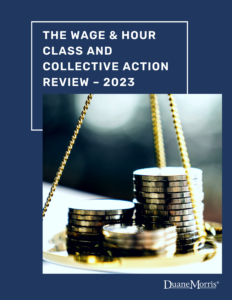 By Gerald L. Maatman, Jr., Gregory Tsonis, and Shaina Wolfe
By Gerald L. Maatman, Jr., Gregory Tsonis, and Shaina Wolfe
Duane Morris Takeaways – Recently, the Illinois General Assembly made substantial modifications to Illinois’ Day and Temporary Labor Services Act (820 ILCS 175/). The legislation drastically alters the legal landscape for staffing agencies and their clients. These amendments, codified in HB2862, were passed on May 19, 2023, and presented to the Governor for signing on June 16, 2023. Absent a veto, the law will automatically come into effect upon the date of the Governor’s approval or no later than August 15, 2023, if no action is taken. The alterations made to the Act are significant and present considerable implications for staffing agencies that employ or utilize day or temporary laborers, as well as their customers. The changes to the Act impose increased obligations and require unprecedented information-sharing between staffing agencies and their customers to ensure compliance with the new requirements. When paired with increased penalties and a third-party enforcement mechanism, staffing agencies and their customers face substantially increased regulatory and compliance burdens and vastly increased exposure to monetary penalties and litigation.
An Overview Of The Changes
The proposed changes can be grouped into various categories, each with its unique impact on staffing agencies and their customers. One element that has not changed, however, is the definition of “day and temporary labor,” which remains defined as “work performed by a day or temporary laborer at a third party client,” but excluding work “of a professional or clerical nature.” 820 ILCS 175/5. The amended Act contains the several significant modifications.
Equivalent Compensation And Benefits
The new legislation requires that day and temporary laborers assigned to a client for more than 90 calendar days must receive equal compensation and benefits (“equal pay for equal work”) as their counterparts directly employed by the client. The requisite equal pay and benefits to qualifying temporary laborers must, at a minimum, match the least paid direct hire at the same seniority level, performing work of a substantially similar nature under substantially similar working conditions. The staffing agency may, in lieu of benefits to a temporary worker, choose to compensate the worker with the cash equivalent of those benefits. In instances where there is no direct hire for comparison, the temporary worker should be paid an equivalent salary and receive the same benefits as the lowest-paid employee at the nearest level of seniority. Furthermore, if a staffing agency requests it, a client company is obligated to supply the staffing agency with all relevant information regarding the job roles, pay, and benefits of directly hired employees.
These changes present significant challenges for staffing agencies and their customers alike. The revised legislation, for example, does not define what “benefits” fall within the Act and which must be provided to qualifying temporary workers and what impact, if any, the staffing agencies’ benefit plans offered to workers have on the requisite compensation. Client companies must provide staffing agencies with the necessary information as to “job duties, pay, and benefits” or risk committing a violation of the Act punishable by a $500 penalty and attorneys’ fees and costs. As a result, the uncertainty injected by the new requirements presents several practical challenges to staffing agencies and client companies alike.
Disclosure Of Labor Disputes
The revised Act requires staffing agencies to inform laborers, before dispatch, if they will be working at a site currently experiencing “a strike, a lockout, or other labor trouble.” 820 ILCS 175/11.
The notice to the temporary worker must be in a language that the worker understands and must inform the worker of the dispute and the worker’s right to refuse the assignment “without prejudice to receiving another assignment.” The phrase “other labor trouble” is undefined in the revised Act, further inserting ambiguity and uncertainty for staffing agencies in compliance with the proposed law.
Safety Inquiries And Training
The amendments also introduce considerable new safety-related responsibilities for both staffing agencies and their client companies.
Prior to assigning a temporary worker, a staffing agency is obligated to inquire into the safety and health practices of the client company, inform the temporary worker about known job hazards, offer general safety training about recognized industry hazards, and document this training. In addition, the agency should give a general overview of its safety training to the client company at the onset of placement, provide temporary workers with the Illinois Department of Labor’s hotline for reporting safety concerns, and instruct the temps on whom to report safety issues to in the workplace.
Simultaneously, client companies are also compelled to adhere to several new safety-related requirements before a temporary worker begins work. Client companies must disclose any anticipated job hazards, review the safety and health awareness training received by the temporary workers from their staffing agencies to ensure its relevance to their specific industry hazards, offer specific worksite hazard training, and maintain records of such training. These records must also be confirmed to the staffing agency within three business days of the training completion. If a temporary worker’s role is altered, the company must provide updated safety training to cover any specific hazards of the new role. In addition, client companies must grant staffing agencies access to the worksite to verify the training and information given to temporary workers.
Increased Fees And Penalties
Under the revised law, fees charged to staffing agencies for registration with the Illinois Department of Labor have increased. Penalties for staffing agencies and client companies in violation of notice requirements have also seen a substantial increase, and now range from $100 to $18,000 per first violation (up from $6,000) and $250 to $7,500 for repeat violations within three years (up from $2,500). Distinct violations may be found on the basis of the type of violation, the day on which the violations occurred, or even each worker impacted by a violation, thereby drastically increasing exposure to staffing agencies and their client companies.
The Illinois Attorney General may even request that a court suspend or revoke the registration of a staffing agency for violating the Act or when warranted by public health concerns.
Third-Party Enforcement
The amendments also provide third-party organizations – defined as any entity “that monitors or is attentive to compliance with public or worker safety laws, wage and hour requirements, or other statutory requirements” – with the power to initiate civil actions to enforce compliance with the Act.
Notably, these “interested parties” can bring suit against staffing agencies and/or their customers if they merely hold a “reasonable belief” that a violation of the Act has occurred in the preceding three years. As a prerequisite to filing suit, these organizations must first file a complaint with the Illinois Department of Labor, which provides notice to the staffing agency or client of the complaint. However, regardless of whether the Department of Labor finds the complaint without merit, or even if the violation is cured, the interested party can still receive a right to sue notice and proceed with litigation. A prevailing party in litigation is entitled to 10% of any assessed penalties, as well as attorneys’ fees and costs.
Implications For Employers
The modifications to the Day and Temporary Labor Services Act present several potential complications and ambiguities for staffing agencies as well as their customers. Notably, the requirement of equal pay for equal work, after a laborer has been with a client for over 90 days, creates substantial issues in what constitutes “equal work,” “equal pay,” and which benefit programs fall within the compensation requirements. Moreover, the provision permitting staffing agencies to pay the hourly cash equivalent of the actual cost benefits in lieu of the required benefits further muddies the waters and requires unprecedented information-sharing between staffing agencies and their clients. Staffing agencies’ obligation to inform temporary workers of “other labor trouble” at client sites is vague, and the lack of a clear definition may lead to compliance issues. Moreover, the increased fees, penalties, and potential civil actions initiated by third-party organizations may lead to additional regulatory and litigation burdens for staffing agencies and clients alike. Finally, the private right of action created by the enactment is sure to prompt class actions by advocacy groups.
These substantial changes call for staffing agencies and their clients to revisit their current policies and practices to ensure compliance with the revised Act before it comes into effect. As the amendments hold significant implications for staffing agencies and client companies alike, early communication and a cooperative approach is recommended to navigate the new requirements effectively. While further guidance from the Department of Labor is likely to clarify several ambiguities in the Act, in the meantime, staffing agencies and client companies should immediately seek legal counsel to better understand the changes, assess the specific impact of each category of changes on their businesses, and ensure compliance to minimize exposure to penalties or litigation.







